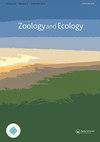Latrine site selection of raccoon dogs in a hilly area in north-eastern Japan
Q4 Environmental Science
引用次数: 2
Abstract
We evaluated the environment types of raccoon dog latrine sites in the hilly areas of north-eastern Japan. We conducted a route census in the spring and autumn of 2020 to record the latrine sites and analysed the relationship between the presence or absence of latrine sites and environmental factors, namely, topographic position index (TPI), slope, normalised difference vegetation index (NDVI), and vegetation type for each season. To investigate the space use of raccoon dogs, we also conducted camera trapping from July to November 2020 along the spring survey route. We analysed the relationship between the occurrence frequency of raccoon dogs and TPI, slope angle, NDVI, and vegetation type. The analysis showed that latrine sites tended to be located at sites with a high TPI (topography closer to the ridge) in both seasons. However, the occurrence of latrine sites in broadleaf forests was significantly higher in autumn. The frequency of raccoon dogs, based on camera-trap footage, was significantly higher at sites with gentle slopes; although the environment and space used by raccoon dogs at these sites differed. Raccoon dogs possibly select visually and olfactorily conspicuous sites on the ridge as latrine sites to facilitate odour dispersal. In addition, broadleaf forests in autumn are considered important feeding grounds for raccoon dogs, suggesting that the latrine sites were formed near foraging sites.日本东北部丘陵地区貉的厕所选址
本研究对日本东北部丘陵地区貉厕所的环境类型进行了评价。我们在2020年春季和秋季进行了路线普查,记录了厕所站点,并分析了每个季节厕所站点的有无与环境因子(地形位置指数(TPI)、坡度、标准化植被指数(NDVI)和植被类型)的关系。为了调查浣熊的空间利用情况,我们还在2020年7月至11月沿春季调查路线进行了相机诱捕。分析了貉的发生频率与TPI、坡角、NDVI和植被类型的关系。分析表明,在两个季节中,厕所站点都倾向于位于TPI高的站点(地形靠近山脊)。而在阔叶林中,厕所站点的发生率在秋季显著增加。根据捕集器录像,在坡度较缓的地点,浣熊的出现频率明显较高;尽管这些地点的环境和空间是不同的。浣熊狗可能会选择在山脊上视觉和嗅觉上明显的地方作为厕所,以促进气味的传播。此外,秋季的阔叶林被认为是浣熊重要的觅食地,这表明厕所地点形成在觅食地点附近。
本文章由计算机程序翻译,如有差异,请以英文原文为准。
求助全文
约1分钟内获得全文
求助全文
来源期刊

Zoology and Ecology
Agricultural and Biological Sciences-Animal Science and Zoology
CiteScore
1.00
自引率
0.00%
发文量
1
 求助内容:
求助内容: 应助结果提醒方式:
应助结果提醒方式:


